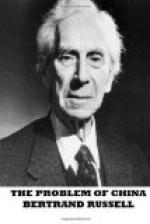To quote Mr. Tyau: “At the end of 1916 the number of factory hands was officially estimated at 560,000 and that of mine workers 406,000. Since then no official returns for the whole country have been published ... but perhaps a million each would be an approximate figure for the present number of factory operatives and mine workers."[108] Of course, the hours are very long and the wages very low; Mr. Tyau mentions as specially modern and praiseworthy certain textile factories where the wages range from 15 to 45 cents a day.[109] (The cent varies in value, but is always somewhere between a farthing and a halfpenny.) No doubt as industry develops Socialism and labour unrest will also develop. If Mr. Tyau is to be taken as a sample of the modern Chinese governing classes, the policy of the Government towards Labour will be very illiberal. Mr. Tyau’s outlook is that of an American capitalist, and shows the extent to which he has come under American influence, as well as that of conservative England (he is an LL.D. of London). Most of the Young Chinese I came across, however, were Socialists, and it may be hoped that the traditional Chinese dislike of uncompromising fierceness will make the Government less savage against Labour than the Governments of America and Japan.
There is room for the development of a great textile industry in China. There are a certain number of modern mills, and nothing but enterprise is needed to make the industry as great as that of Lancashire.
Shipbuilding has made a good beginning in Shanghai, and would probably develop rapidly if China had a flourishing iron and steel industry in native hands.
The total exports of native produce in 1919 were just under L200,000,000 (630,000,000 taels), and the total imports slightly larger. It is better, however, to consider such statistics in taels, because currency fluctuations make the results deceptive when reckoned in sterling. The tael is not a coin, but a certain weight of silver, and therefore its value fluctuates with the value of silver. The China Year Book gives imports and exports of Chinese produce for 1902 as 325 million taels and 214 million taels respectively; for 1911, as 482 and 377; for 1917, as 577 and 462; for 1920, as 762 and 541. (The corresponding figures in pounds sterling for 1911 are 64 millions and 50 millions; for 1917, 124 millions and 99,900,000.) It will thus be seen that, although the foreign trade of China is still small in proportion to population, it is increasing very fast. To a European it is always surprising to find how little the economic life of China is affected by such incidents as revolutions and civil wars.
Certain principles seem to emerge from a study of the Chinese railways and mines as needing to be adopted by the Chinese Government if national independence is to be preserved. As regards railways, nationalization is obviously desirable, even if it somewhat retards the building of new lines. Railways not in the hands of the Government will be controlled, in the end if not in the beginning, by foreigners, who will thus acquire a power over China which will be fatal to freedom. I think we may hope that the Chinese authorities now realize this, and will henceforth act upon it.




